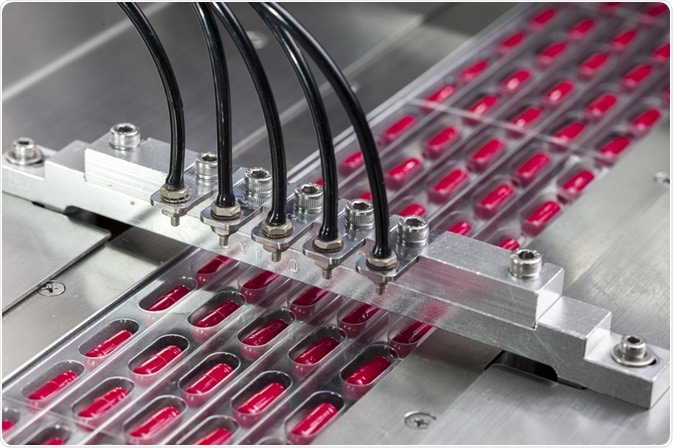Analytical chemistry has a significant presence in the pharmaceutical industry, especially in the drug development process providing quality assurance, safety, and efficacy of new medicines. There are several analytical techniques used in the pharmaceutical industry, but the techniques commonly used are chromatography techniques such as HPLC, LC-MS, GC, and GC-MS.

Image Credit: Planar/Shutterstock.com
These techniques form the industry standard for analyzing polymorphism in new drugs. However, spectroscopic instrumentation is also used in the industry due to its accuracy and speed of measurement. The drug development process begins with an innovative drug molecule that shows therapeutic value to treat or prevent disease.
The effective synthesis and characterization of these drug molecules, also known as active pharmaceutical ingredients (APIs), is extremely important to identify drug candidates that treat or prevent disease, which can be released to the public. Hence, having effective analytical methods to facilitate the drug manufacturing process and characterize drug candidates throughout the process is critical.
What is analytical chemistry?
Analytical chemistry uses instruments and methods to separate, detect and quantify matter. All three methods can be used separately or combined with another method. Separation isolates certain molecules. Qualification methods are used to identify and detect analytes, while quantitative methods determine the concentration of an analyte.
Furthermore, analytical chemistry involves the use of classical, wet chemistry methods and instrumental methods. Precipitation, extraction, and distillation are classical qualitative methods used in separation. Other methods of identification include differences based on color, melting point, boiling point, solubility, or radioactivity. Moreover, common quantitative analytical methods use mass or volume changes to quantify the amount.
Typically, chromatography, electrophoresis, or field-flow fractionation are the main instrumental methods used for separation. Once the target analyte has been isolated, qualitative and quantitative methods can be used to determine concentration. This is often achieved by either using the same instrument after separation or using alternative spectroscopic methods for further characterization and analysis. Often the classical instrumental methods use the same instrument to separate, detect and quantify samples.
However, spectroscopic instrumentation is often used as a complementary technique because it has the advantage of differentiating molecules that might have the same elution time with chromatography, but different molecular characteristics. Moreover, chemometrics and multivariate statistics are used in conjunction with these techniques to further elucidate the structure and detect principal components at low concentrations. This is especially important in the pharmaceutical industry.
Analytical techniques in pharmaceutical industry
Within the pharmaceutical industry, there are three broad analytical techniques adopted for determining structure, separating analytes, and quantifying target molecules. These include classical analytical chemistry methods, chromatography, and spectroscopy. A common classical analytical approach is using the titrimetric method, which is a quick qualitative technique for determining the presence of a particular analyte or pharmaceutical ingredient.
The optimization of function group procedures has allowed for the analysis of kinetic measurements to establish reaction rates. Within the pharmaceutical industry determination of certain pharmaceutical ingredients such as captopril, gabapentin, and sparfloxacin in commercial dosage forms using these methods have been achieved.
Chromatography methods have a strong presence in the pharmaceutical industry due to their accuracy of separation and detection. Thin-layer chromatography (TLC) is a technique for screening unknown materials in bulk drugs. It provides a qualitative approach in that all likely constituents of the drug are separated. An advanced version of the technique is high-performance TLC, which has the advantage of a faster run time to analyze complex mixtures and multiple samples or drugs.
Furthermore, high-performance liquid chromatography (HPLC) is used to separate complex mixtures and has high specificity, precision, and accuracy. There are several detectors used for HPLC, but a commonly used detector is UV due to its capability of monitoring various wavelengths at once. HPLC can analyze several drugs in the pharmaceutical formulation process and has been a dominating technique in the industry. Moreover, when coupled with mass spectrometry (LC-MS) it is has been a new gold standard for quality control and assurance within the industry. Another chromatography separation technique typically used in the industry is gas chromatography, which detects volatile organic compounds. It is used in the pharmaceutical industry to analyze impurities and residual solvents.
Alternatively, spectroscopic methods play an important role in the pharmaceutical industry because they are low-cost, fast, and highly accurate. Common analytical techniques used are Raman and infrared spectroscopy. Near-infrared spectroscopy (NIRS) is most widely used in the pharmaceutical industry and is a rapid and non-destructive procedure that can analyze almost any matrix. It is mainly used for raw material testing, quality control, and process monitoring. It has general acceptance in the pharmaceutical industry because of easy sample preparation to detect physicochemical properties from a single spectrum.
Hence, the role of analytical chemistry in the pharmaceutical industry mainly lies in the efficient and effective detection and characterization of pharmaceutical ingredients for maintaining high-quality assurance and quality control.
Sources:
- R. Valagaleti, P.K. Burns, Michael Gill.; Drug Inform. J., 37 (2003), pp. 407-438.
- Skoog, Douglas A.; West, Donald M.; Holler, F. James; Crouch, Stanley R. (2014). Fundamentals of Analytical Chemistry. Belmont: Brooks/Cole, Cengage Learning. p. 1.
- N. Rahman, N. Anwar, M. Kashif.; IL Farmaco, 60 (2005), pp. 605-611.
- K. Basavaiah, H.C. Prameela.; IL Farmaco, 58 (2003), pp. 527-534.
- A.M. Sameer, K. Abdulrahman Basavaiah.; C I and C E Q, 17 (2011), pp. 173-178.
- H.R.N. Marona, E.E.S. Schapoval.; Eur. J. Pharm. Biopharm., 52 (2001), pp. 227-231.
- G. Szepesi, S. Nyiredy.; Pharmaceutical and drugs.; J. Sherma, B. Fried (Eds.), Handbook of Thin-Layer Chromatography (2nd ed.), Marcel Dekker, New York (1996), pp. 208-235
- M.R. Siddiqui, A. Tariq, K.D. Reddy, M. Chaudhary, J. Yadav, P.S. Negi, A. Bhatnagar, R. Singh.; Int. J. Pharmacol., 6 (2010), pp. 271-277.
- J. Ermer.; J. Pharm. Biomed. Anal., 18 (1998), pp. 707-714.
Further Reading
Last Updated: Sep 12, 2022